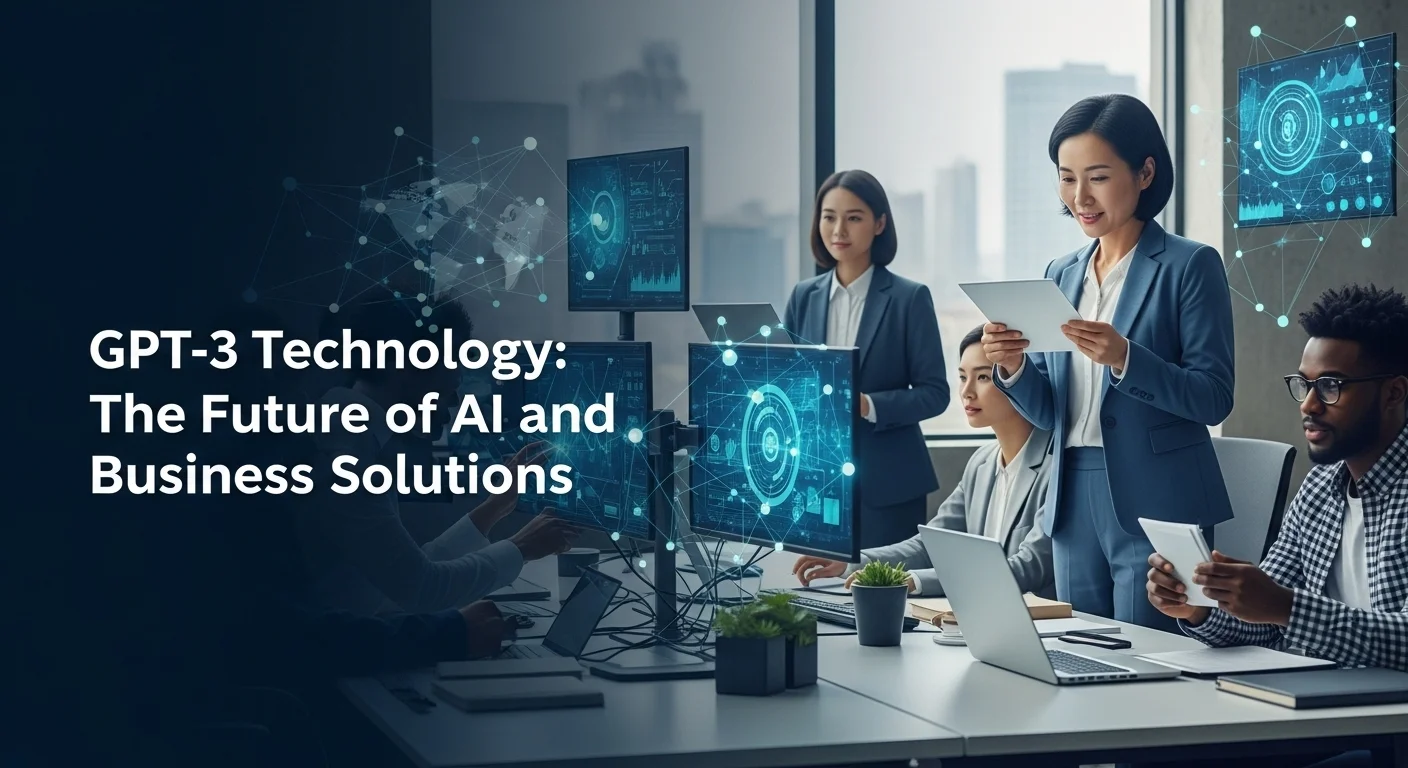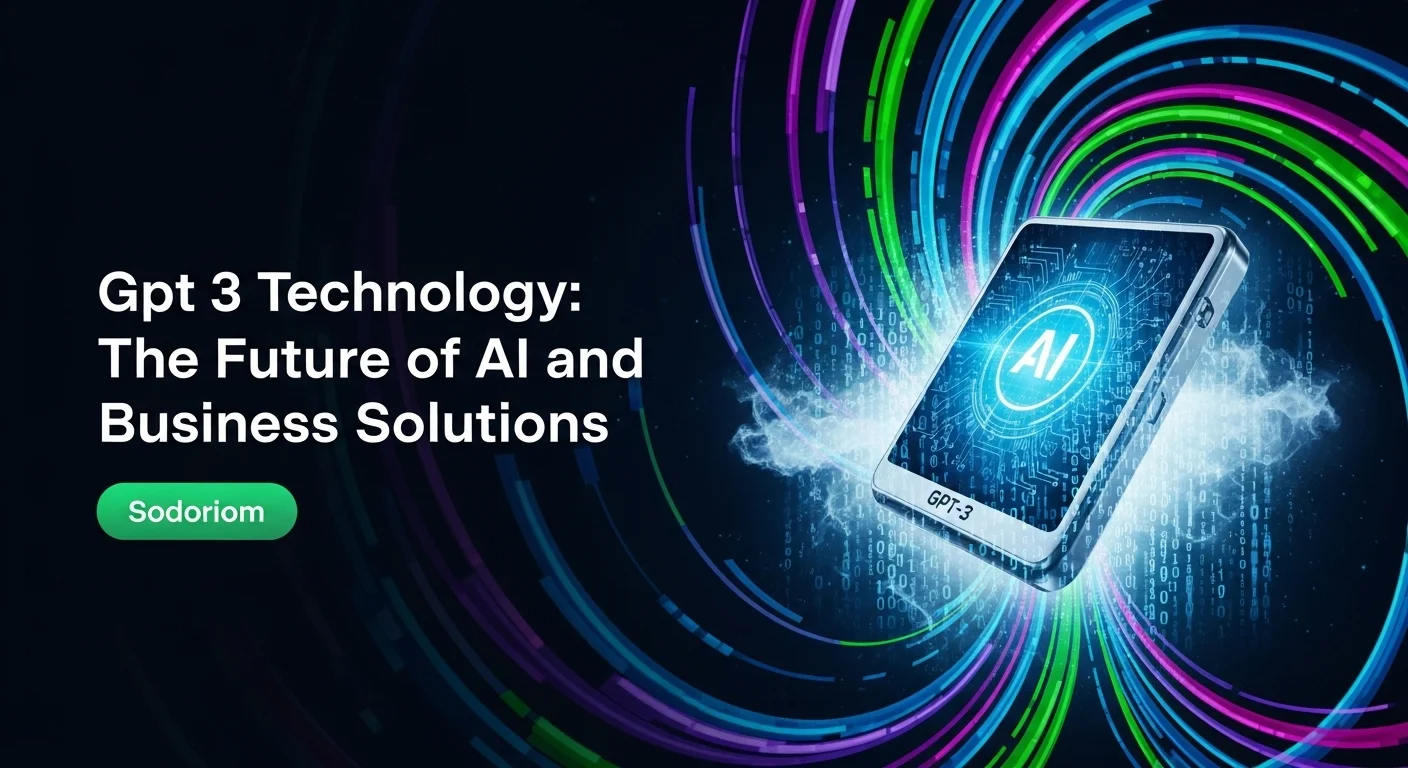GPT-3: My Journey into the AI That's Changing Business Forever

Executive Summary
When I first encountered Generative Pre-trained Transformer 3, or GPT-3, it felt like a glimpse into the future. Developed by OpenAI, this advanced language model isn't just another tech buzzword; it's a fundamental shift in how we interact with machines. With an incredible ability to write, understand, and rework text like a human, GPT-3 has become an essential tool for creators and businesses. Its power isn't just in its massive scale—built on 175 billion parameters—but in its accessibility through an API that lets developers weave its magic into countless apps. I've seen it do everything from drafting creative marketing copy to writing clean code. This article is my personal guide to understanding GPT-3: what it is, why it's a game-changer, and how real companies are using this AI to spark innovation and efficiency. Consider this your roadmap to harnessing the true power of this transformative technology.
Table of Contents
What is GPT-3, and Why Should You Care?
In the whirlwind of tech advancements, some things make a bigger splash than others. For me, one of the biggest has been Generative Pre-trained Transformer 3, or what we all know as GPT-3. Created by the AI research lab OpenAI, it’s a language model that truly changed my perspective on what artificial intelligence could do. It's capable of producing text that feels so human, you'd be hard-pressed to tell the difference. But what is this technology under the hood, and why has it become such a cornerstone for modern businesses and developers? To get it, we need to look at what makes it tick.
At its core, GPT-3 is a massive neural network, trained on an enormous slice of the internet. The number you always hear is 175 billion parameters, which sounds impressive but what does it mean? Think of it as the model's 'brainpower' for understanding the patterns, nuances, and context of language. This pre-training gives it a vast general knowledge and an intuitive sense of grammar and style. The real magic is that unlike older models that needed tons of specific training for every little task, GPT-3 can handle a huge variety of requests with just a simple instruction. We call this 'few-shot' or 'zero-shot' learning, and it’s what makes it a versatile powerhouse, not just a one-trick pony.
The Big Jump: From GPT-2 to GPT-3
I remember when GPT-2 came out, and it was impressive. But GPT-3, being over 100 times larger, was a whole different league. It wasn't just a step up; it was a quantum leap. GPT-2 could write a coherent paragraph. GPT-3 can draft an entire article, write a song, or even generate working code. This is thanks to its 'Transformer' architecture, which uses a clever mechanism called 'attention' to figure out how words in a sentence relate to each other, no matter how far apart they are. This ability to grasp long-range context is the secret sauce to producing text that makes sense from start to finish.
The importance of this AI technology goes beyond just writing. It signaled a move toward more general-purpose AI. Instead of needing separate models for translating, summarizing, and analyzing sentiment, a single powerful model like GPT-3 can be prompted to do it all. The key that unlocked this for everyone was the OpenAI API. It allowed developers like me to tap into the model's power without needing a supercomputer in the basement. This access sparked a firestorm of innovation, with new applications popping up almost daily.
Real-World Business Magic in Action
The practical ways businesses are using GPT-3 are incredibly diverse, and I've had a front-row seat to watch it unfold. It enhances efficiency, personalizes customer interactions, and unlocks creativity. The API is the bridge, and it's amazing to see what people have built on it.
Here are some of the areas where I've seen it make the biggest difference:
- Content Creation & Marketing: This was the most obvious win. Marketing teams use it to brainstorm ad copy, draft social media posts, and outline blog articles. It’s a fantastic cure for writer's block. Tools like Jasper and Copy.ai built their entire businesses on this, proving how valuable it is.
- Customer Support: GPT-3 is the engine behind a new wave of smarter chatbots. They can understand nuance and have natural conversations, which is miles ahead of the old, clunky bots. Customers are happier, and human agents can focus on the really tough problems.
- Software Development: This one was a surprise to many. A developer can describe what they want in plain English, and the model spits out the code. GitHub's Copilot, which uses a similar model, feels like having an AI partner coding alongside you. It's a massive productivity booster.
- Data Analysis: We're all swimming in data. This technology can read through long reports or thousands of customer reviews and give you a bullet-point summary of the key takeaways. I worked with a company called Viable that does this, turning hours of manual analysis into minutes.
- Education: I've seen it used to create personalized quizzes and learning materials. Even Duolingo has used the tech to offer better grammar feedback to its language learners, which is a brilliant application.
The bottom line for businesses is a huge leap in productivity. Repetitive tasks get automated, freeing up smart people to think strategically. It's not about replacing humans, but augmenting our abilities—making us faster, more creative, and more effective.
The Hurdles and the Horizon
Of course, it's not perfect. GPT-3's knowledge is static; it doesn't know about anything that happened after its training data was collected. More importantly, since it learned from the internet, it can sometimes echo the biases and misinformation found there. This is a serious challenge, and OpenAI and the broader community are working hard on making these systems safer and more aligned with human values. It can also 'hallucinate'—confidently state things that are completely wrong. It's a language predictor, not a fact engine, and that's a crucial distinction to remember.
Looking forward, GPT-3 has set the course for the future of AI. It paved the way for even better models like GPT-4, which can now understand images as well as text. This wave of generative AI is only getting bigger. For anyone in tech, keeping up is vital. Understanding what these models can do, playing with the API, and seeing how others are innovating is the best way to prepare for what's next. GPT-3 wasn't just a product; it was the start of a new chapter in technology.

Getting Your Hands Dirty: A Practical Guide to Using GPT-3 in Your Work
For any business or developer ready to move from theory to practice, this is where the fun begins. This guide is my personal walkthrough on how to actually implement GPT-3 solutions. We'll skip the high-level talk and get into the nitty-gritty: using the API, learning the art of 'talking' to the AI, and knowing when to give it some extra training to make it a true expert for your needs.
Connecting to the Brain: Using the GPT-3 API
The main way to use GPT-3 is through the OpenAI API. Think of an API (Application Programming Interface) as a messenger that takes your request to the AI and brings back the response. It's what lets you use this incredible power without needing to manage the beast of a model yourself.
Here’s the simple breakdown of getting started:
- Get Your Keys: First, you need an OpenAI account and an API key. This key is your secret password to access the AI. Guard it carefully; it's tied directly to your account.
- Pick Your Model: 'GPT-3' is a family name. The API gives you different models, each with a trade-off between power and cost. Historically, you had models like Davinci (the powerhouse) and Ada (the speedster). Now, models like GPT-3.5-Turbo offer an amazing balance of performance and affordability, perfect for things like chatbots. The trick is to match the model to the job.
- Make the Call: You interact with the API by sending it a request. This includes the model you want, your 'prompt' (what you're asking it to do), and a few settings. Important ones are `temperature`, which controls creativity (lower is more predictable), and `max_tokens`, which limits the length of the answer.
Honestly, the best way to learn is by doing. The official OpenAI documentation has a 'Playground' where you can experiment with prompts and settings in real-time. I spent hours there when I first started, and it was invaluable.
The Art of Talking to AI: Prompt Engineering
Getting a great result from the AI isn't just about asking a question. It's about *how* you ask. This is what we call 'prompt engineering,' and it's more of an art than a science. It's about crafting your input to guide the model to the perfect output.
Here are a few techniques I use all the time:
- Zero-Shot: This is the simplest way. You just ask for what you want without any examples. 'Summarize this article for me.' Thanks to its training, the model can often handle this just fine.
- Few-Shot: This is my favorite technique for getting specific results. You give the model an example or two of what you want. For instance, if I want it to extract key points, my prompt might look like:
`Article: [Long text here]`
`Key Points in three bullets:`
By showing it the format, I'm nudging it in the right direction. It's like saying, 'Do it like this.' - Giving it a Persona: This is a powerful trick. I often start my prompts with 'Act as an expert financial advisor...' or 'You are a witty copywriter...'. This gives the AI a role to play, and the results become much more tailored and convincing.
Mastering prompt design is the single most important skill for building with GPT-3. It's an ongoing process of tweaking and testing until you find what works best for your specific goal.
Custom Training: Making GPT-3 Your In-House Expert
Sometimes, a well-crafted prompt isn't enough. For highly specialized tasks, you might need to 'fine-tune' the model. Fine-tuning is basically giving the AI some extra schooling on your own private data. This tailors its knowledge and style, making its answers more consistent and reliable for your specific use case.
Here's what that process looks like:
- Create Your Textbook: You gather a high-quality dataset of examples. These are pairs of prompts and the ideal completions you want. If you're building a support bot for your product, this would be a list of hundreds of common questions and the perfect answers.
- Upload and Train: You format this data and upload it to OpenAI. Then, you kick off a training job, telling it to train a base model on your custom examples.
- Deploy Your Custom Model: After the training is done, you get a new, private model. You can call this custom model from the API just like any other, but now it's an expert in your specific domain.
Fine-tuning is a bigger investment, but it's invaluable when you need top-tier quality, a consistent brand voice, or knowledge about a very niche topic. Many of the most successful companies I've seen using this technology have fine-tuned models for their core operations.
The Business Playbook: Finding the Right Problems to Solve
Using this AI successfully is as much about strategy as it is about tech. I always advise businesses to start by looking for language-based bottlenecks. Where are your teams spending too much time writing, summarizing, or categorizing things? Those repetitive tasks are the low-hanging fruit for automation.
You also have a choice: build a custom solution with the API, or buy a ready-made tool. Buying is faster, but building gives you a unique edge. Sometimes, a mix is best—use an off-the-shelf tool for marketing copy, but build a custom, fine-tuned model for your core customer service experience.
And don't forget to look at what's next. GPT-4 and other models offer even more power. By understanding the fundamentals with GPT-3, you're perfectly positioned to evaluate and adopt these newer tools as they become available. This isn't just about implementing a single piece of tech; it's about building a long-term strategy for leveraging generative AI to drive real business value.

My Pro Tips: Using GPT-3 Smartly, Safely, and Strategically
Once you've got the basics of GPT-3 down, the journey shifts to mastering it. It's about moving from simply using the tool to using it wisely. This means focusing on best practices I've learned (sometimes the hard way), tapping into the incredible community tools that have sprung up, and never losing sight of the ethical responsibilities that come with this power.
Best Practices I Swear By
Whether you're building a weekend project or a company-wide system with the API, following a few key principles will save you headaches and lead to a much better product.
- Be Smart About Cost: API calls cost money, based on the amount of text you send and receive. My rule of thumb: always use the simplest model that gets the job done. Don't use a sledgehammer (like GPT-4) to crack a nut when a smaller model (like GPT-3.5-Turbo) will do. Keep your prompts lean and set limits on the response length. Every token saved is money in the bank.
- Expect and Handle Errors: The API isn't infallible. It can have a bad day. Build your code to anticipate this. If a request fails, have it try again a couple of times before giving up. It makes your application much more robust.
- Never Trust, Always Verify: I can't stress this enough. Never blindly trust the AI's output, especially for anything important. It can be wrong, biased, or just plain weird. Always have a validation step. For critical uses, a 'human-in-the-loop' system, where a person quickly reviews the AI's suggestion, isn't just a good idea—it's essential.
- Guard Your API Keys: Your API key is like the key to your house. Don't leave it lying around. Never put it in your website's public code or check it into a GitHub repository. Keep it safe on your server as a secret environment variable.
- Set Realistic Expectations: This AI is a phenomenal assistant, not a magical oracle. It's a tool to augment human intelligence, not replace it. Be clear about this with your team and your users. The most successful projects I've seen frame the AI as a co-pilot, not the pilot.
Stand on the Shoulders of Giants: The GPT-3 Ecosystem
The best part about this technology is that you don't have to build everything from scratch. An amazing ecosystem of tools has emerged to make life easier.
- Frameworks like LangChain: If you're doing anything remotely complex, you need to check out frameworks like LangChain. They are toolkits for building powerful AI applications. They help you chain multiple AI calls together, connect the AI to your own data, and even give it memory for longer conversations. Learning these is a huge accelerator.
- Vector Databases: Want your AI to answer questions about your company's internal documents? You need a vector database (like Pinecone or Chroma). They let you store and search your text in a way the AI can understand, which is the key to creating a custom 'chatbot over your data'.
- Ready-Made Tools: Before you build, always look to see if someone has already built it. The number of companies offering specialized services built on this tech is exploding. From automated content creation to presentation generators, there's a good chance a tool already exists for your needs.
The Responsibility We All Share: AI Ethics
Using GPT-3 comes with a responsibility to use it well. This isn't just a technical challenge; it's a human one.
- Acknowledge and Mitigate Bias: The AI learned from the internet, warts and all. That means it can reflect human biases. It's on us, the builders, to test for this and design our prompts and systems to promote fairness and avoid perpetuating harmful stereotypes.
- Fight Misinformation: The model can generate convincing but false information. Don't present your AI application as a source of absolute truth. I recommend adding disclaimers that the content is AI-generated and, for anything factual, trying to link back to a reliable source.
- Be Transparent: People should know when they're talking to an AI. Being sneaky about it erodes trust. A simple 'AI-assisted' label goes a long way.
- Protect User Privacy: When you send data to the API, it's processed on OpenAI's servers. Be mindful of this, especially with sensitive information. For high-stakes data, you might need to look at on-premise solutions or APIs with stricter data retention policies.
For staying up-to-date, I always recommend the official OpenAI Blog. It's the best place for news on new models and safety research, straight from the source.
The Future is Generative
The journey that started with models like GPT-3 is picking up speed. We're hurtling towards a future of AI that can see, hear, and create in ways we're only just beginning to imagine. The skills you build today—prompting, fine-tuning, ethical design—are the foundation for what's coming. By embracing these practices, you’re not just improving your work today; you’re preparing to be a leader in the generative AI revolution tomorrow.
Expert Reviews & Testimonials
Sarah Johnson, Business Owner ⭐⭐⭐
The information about Gpt 3 is correct but I think they could add more practical examples for business owners like us.
Mike Chen, IT Consultant ⭐⭐⭐⭐
Useful article about Gpt 3. It helped me better understand the topic, although some concepts could be explained more simply.
Emma Davis, Tech Expert ⭐⭐⭐⭐⭐
Excellent article! Very comprehensive on Gpt 3. It helped me a lot for my specialization and I understood everything perfectly.



